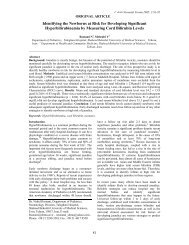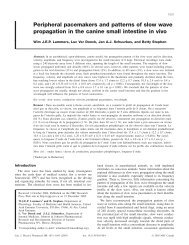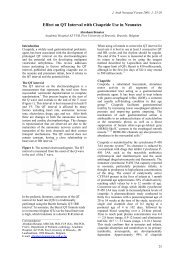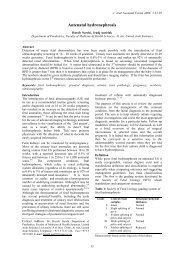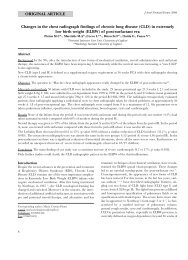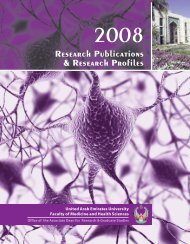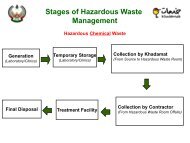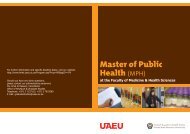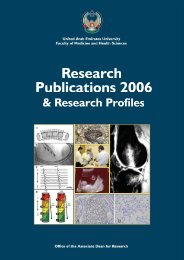Research Publications - College of Medicine and Health Science
Research Publications - College of Medicine and Health Science
Research Publications - College of Medicine and Health Science
Create successful ePaper yourself
Turn your PDF publications into a flip-book with our unique Google optimized e-Paper software.
�<br />
�<br />
�<br />
Department <strong>of</strong> Obstetrics & Gynaecology<br />
52<br />
Figure 1<br />
Figure 2<br />
Figure 3<br />
large number <strong>of</strong> mitochondria <strong>and</strong> different<br />
shapes. However, the number <strong>of</strong> mitochondria<br />
decreased significantly in diabetic placentas.<br />
The plasma membrane <strong>of</strong> syncytiotrophoblasts<br />
<strong>of</strong> the chorionic villi in the control subjects is<br />
highly invaginated. These membranous invaginations<br />
disappear in the syncytiotrophoblasts <strong>of</strong><br />
diabetic patients.<br />
The chorionic villi in diabetic patients contain<br />
fewer blood vessels when compared to that <strong>of</strong><br />
control. In addition the wall <strong>of</strong> fetal capillaries is<br />
thicker in the placenta <strong>of</strong> diabetic patients compared<br />
to control (Figure 3: a; control, b; diabetic).<br />
Placentas <strong>of</strong> type 2 diabetes are associated with<br />
significant ultrastructural changes. This involves<br />
the villi, syncytiotrophoblast <strong>and</strong> fetal capillary<br />
vessels. These changes might explain the poor<br />
perinatal outcome associated with pregnancy<br />
complicated with type 2 diabetes.<br />
��������������������������������������������<br />
in-vitro human placenta model<br />
The ex vivo model <strong>of</strong> human placental cotyledon<br />
model is performed to compare viability<br />
parameters (metabolic, permeability, <strong>and</strong><br />
ultra-structure) between uncomplicated normal<br />
pregnancies, <strong>and</strong> pregnant women on insulin.<br />
Future Placenta Projects<br />
1. The objective <strong>of</strong> the study is to determine the<br />
placental transfer <strong>of</strong> 2-naphthol (Naphthalene)<br />
using an ex-vivo human placenta perfusion<br />
model.<br />
Naphthalene is a member <strong>of</strong> the polycyclic<br />
aromatic hydrocarbons (PAHs) group. They are<br />
one <strong>of</strong> the most widespread organic pollutants.<br />
(PAHs) are potent atmospheric pollutants that<br />
consist <strong>of</strong> fused aromatic rings <strong>and</strong> do not contain<br />
heteroatoms or carry substituent.<br />
Naphthalene is the simplest example <strong>of</strong> a PAH.<br />
Naphthalene is used mainly as a precursor to<br />
other chemicals. The single largest use <strong>of</strong> naphthalene<br />
is the industrial production <strong>of</strong> phthalic<br />
anhydride (plasticizers for plastics). Hemolytic<br />
anemia has been reported in infants born to<br />
mothers who were exposed to high levels <strong>of</strong><br />
naphthalene vapors during pregnancy.<br />
Naphthalene was detected in human breast<br />
milk. The umbilical cord blood <strong>of</strong> pregnant<br />
women exposed to naphthalene contains el-




